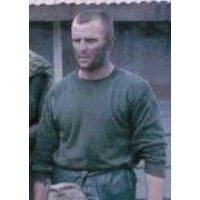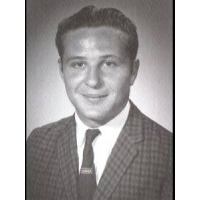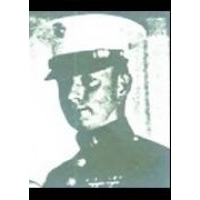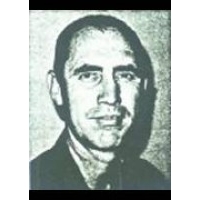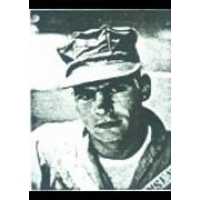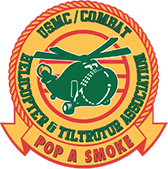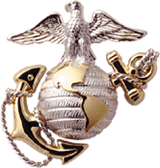
Brothers (& Sisters) Killed in Action in USMC Helicopters or while assigned to USMC Helicopter or Tiltrotor Squadrons
19680216VMO-6 Vietnam
Download PDFIncident Date 19680216 VMO-6 UH-1E 151291+ - Hostile Fire, Crash
Tolliver, Jimmy Ellison SSgt Gunner VMO-6 MAG-36 1968-02-16 (vvm 39E:067)
Schneider, Harry Warren Cpl Crew Chief VMO-6 MAG-36 1968-02-16 (vvm 39E:066)
Jensen, Paul Andrew 1stLT Co-Pilot VMO-6 MAG-36 1968-02-16 (vvm 39E:057)
Galbreath, Bobby Frank Capt Pilot VMO-6 MAG-36 1968-02-16 (vvm 39E:059)
[PASSENGERS]
Honeycutt, James Earl PFC Passenger 3rdForRec/3rdRecBn 3rdMarDiv 1968-02-16 (vvm 39E:075)
Graves, Terrence Collinson 2ndLt Passenger 3rdForRec/3rdRecBn 3rdMarDiv 1968-02-16 (vvm 39E:071)
Personal Comment
We where coming up on the area just as they where lifting off. They got hit and went straight into the ground. Four very close friends plus the recon men. We flow over to give cover and Cpl Paul Rich got hit in the leg. We took him to Delta Med; then returned to give cover fire after being hit ourselves. Col White would not leave until we ran out of ammo! Went back to Quang Tri; bird not flight worthy. Col White got another bird and went back. Next morning we where able to get bodies out. Cpl Snider was the only one still alive! But after 3-4 times of dying and being brought back, he finally passed. All these Marines where good men and will be missed forever!!! Will live with me Forever!!!!
Submitted by: JACK , Was there in huey just as they got hit, 20140413Personal Narrative
The UH-1E Gunship that crashed was from VMO-6. The Pilot Capt Frank "Pappy" Galbreath was posthumously awarded the Navy Cross. The remaining crew, Lt Paul Jensen, Cpl Harry Schneider (Crew Chief) and SSgt Jimmie Tolliver (Gunner) were also killed.
Submitted by: Marty Scanlon, VMO-6 68-69, 20030818MEDAL OF HONOR CITATION - 2ndLt Terrence C. Graves - 16FEB68
“For conspicuous gallantry and intrepidity at the risk of his life above and beyond the call of duty as a platoon commander with the 3rd Force Reconnaissance Company. While on a long-range reconnaissance mission, 2nd Lt. Graves' 8-man patrol observed 7 enemy soldiers approaching their position. Reacting instantly, he deployed his men and directed their fire on the approaching enemy.  After the fire had ceased, he and 2 patrol members commenced a search of the area, and suddenly came under a heavy volume of hostile small arms and automatic weapons fire from a numerically superior enemy force. When 1 of his men was hit by the enemy fire, 2nd Lt. Graves moved through the fire-swept area to his radio and, while directing suppressive fire from his men, requested air support and adjusted a heavy volume of artillery and helicopter gunship fire upon the enemy. After attending the wounded, 2nd Lt. Graves, accompanied by another marine, moved from his relatively safe position to confirm the results of the earlier engagement. Observing that several of the enemy were still alive, he launched a determined assault, eliminating the remaining enemy troops. He then began moving the patrol to a landing zone for extraction, when the unit again came under intense fire which wounded 2 more marines and 2nd Lt. Graves. Refusing medical attention, he once more adjusted air strikes and artillery fire upon the enemy while directing the fire of his men. He led his men to a new landing site into which he skillfully guided the incoming aircraft and boarded his men while remaining exposed to the hostile fire. Realizing that 1 of the wounded had not embarked, he directed the aircraft to depart and, along with another marine, moved to the side of the casualty. Confronted with a shortage of ammunition, 2nd Lt. Graves utilized supporting arms and directed fire until a second helicopter arrived. At this point, the volume of enemy fire intensified, hitting the helicopter and causing it to crash shortly after liftoff. All aboard were killed. 2nd Lt. Graves' outstanding courage, superb leadership and indomitable fighting spirit throughout the day were in keeping with the highest traditions of the Marine Corps and the U.S. Naval Service. He gallantly gave his life for his country.”
After the fire had ceased, he and 2 patrol members commenced a search of the area, and suddenly came under a heavy volume of hostile small arms and automatic weapons fire from a numerically superior enemy force. When 1 of his men was hit by the enemy fire, 2nd Lt. Graves moved through the fire-swept area to his radio and, while directing suppressive fire from his men, requested air support and adjusted a heavy volume of artillery and helicopter gunship fire upon the enemy. After attending the wounded, 2nd Lt. Graves, accompanied by another marine, moved from his relatively safe position to confirm the results of the earlier engagement. Observing that several of the enemy were still alive, he launched a determined assault, eliminating the remaining enemy troops. He then began moving the patrol to a landing zone for extraction, when the unit again came under intense fire which wounded 2 more marines and 2nd Lt. Graves. Refusing medical attention, he once more adjusted air strikes and artillery fire upon the enemy while directing the fire of his men. He led his men to a new landing site into which he skillfully guided the incoming aircraft and boarded his men while remaining exposed to the hostile fire. Realizing that 1 of the wounded had not embarked, he directed the aircraft to depart and, along with another marine, moved to the side of the casualty. Confronted with a shortage of ammunition, 2nd Lt. Graves utilized supporting arms and directed fire until a second helicopter arrived. At this point, the volume of enemy fire intensified, hitting the helicopter and causing it to crash shortly after liftoff. All aboard were killed. 2nd Lt. Graves' outstanding courage, superb leadership and indomitable fighting spirit throughout the day were in keeping with the highest traditions of the Marine Corps and the U.S. Naval Service. He gallantly gave his life for his country.”
2ndLt Terrence C. Graves, MOH
Submitted by: POPASMOKE Admin, 20050207NAVY CROSS CITATION - Capt Bobby F. Galbreath - 16FEB68
“For extraordinary heroism while serving as a Pilot with Marine Observation Squadron SIX, in the Republic of Vietnam on 16 February 1968. Captain Galbreath launched as Wingman in a flight of two armed UH-1E helicopters diverted to support the emergency extraction of an eight-man reconnaissance team which was heavily engaged with a numerically superior North Vietnamese Army force six miles northwest of Dong Ha. Arriving over the designated area, he immediately initiated his attack and made repeated strafing runs on the enemy positions. Although five Marines had been recovered, subsequent attempts to rescue the remaining men failed due to a heavy volume of ground fire, which had seriously damaged three helicopters. Realizing the seriousness of the situation, Captain Galbreath volunteered to evacuate the surrounded men. Fully aware of the extreme danger to himself and his crew, he unhesitatingly commenced his approach, but was forced to abandon the landing when his aircraft sustained several hits. Completely disregarding his own safety, he initiated his second approach and skillfully maneuvered his aircraft through the hostile fire into the landing zone. Ignoring the intense fire, which was striking his aircraft, he remained in the fire swept area while the men embarked. Lifting from the hazardous zone, his helicopter was struck by a burst of enemy fire and crashed, mortally wounding Captain Galbreath. By his courage, bold initiative and selfless devotion to duty, he inspired all who served with him and upheld the highest traditions of the Marine Corps and the United States Naval Service. He gallantly gave his life for his country.”
NAVY CROSS CITATION - Pvt James E. Honeycutt - 16FEB68
"For extraordinary heroism while serving with the Third Force Reconnaissance Company, Third Reconnaissance Battalion, Third Marine Division (Reinforced), in connection with operations against the enemy in the Republic of Vietnam on 16 February 1968. While on patrol southeast of Con Thien, Private Honeycutt's team established an ambush when seven enemy soldiers were observed moving toward their position. During the initial exchange of fire, one Marine was seriously wounded. Disregarding his own safety, Private Honeycutt moved to an exposed area where he provided covering fire for the corpsman who was treating the injured man. After annihilating the enemy force, the team moved toward a landing zone to evacuate the casualty. As the team moved forward, they were taken under devastating enemy small-arms, automatic-weapons and mortar fire from an estimated two companies of North Vietnamese soldiers. In the initial burst of enemy fire, three Marines were wounded. With complete disregard for his own safety, Private Honeycutt moved across the fire-swept terrain to the side of an injured comrade and administered first aid. He then provided covering fire and assisted in moving the casualties across forty meters of fire-swept terrain to a waiting evacuation helicopter. Displaying exceptional courage, he remained behind to deliver a heavy volume of fire that suppressed hostile fire sufficiently to allow the team to embark. Only after all were aboard did he then embark. Realizing that a wounded man remained in the zone and that the injured team leader had debarked to search the hazardous area, he unhesitatingly jumped from the helicopter to aid his fellow Marines. Upon the arrival of the second extraction aircraft, he then assisted his wounded comrades aboard. By his bold initiative, intrepid fighting spirit and loyal devotion to duty, Private Honeycutt reflected great credit upon himself and the Marine Corps and upheld the highest traditions of the the United States Naval Service."
Submitted by: N/A, 20050207SILVER STAR CITATION - PFC Adrian S Lopez - 16FEB68
"For conspicuous gallantry and intrepidity in action while serving as a Rifleman with Third Force Reconnaissance Company, Third Reconnaissance Battalion, Third Marine Division (Reinforced), in connection with operations against the enemy in the Republic of Vietnam. On 16 February 1968, Private Lopez was a member of a reconnaissance patrol operating southeast of Con Thien when they made contact with several North Vietnamese soldiers and during the brief fire-fight, one Marine was wounded. Exposing himself to the enemy fire, Private Lopez provided covering fire while the corpsman administered first aid to the casualty. Subsequently, while moving to a helicopter landing zone to evacuate the casualty, the Marines suddenly came under intense automatic weapons fire from a numerically superior force and sustained three additional casualties. Realizing the seriousness of the situation, Private Lopez unhesitatingly directed a heavy volume of automatic rifle fire upon the hostile positions, attracting the attention and fire of the enemy away from the wounded. Moving to the side of a casualty, he ignored the enemy fire impacting around him and assisted in administering first aid. As a medical evacuation helicopter approached the landing site, he assisted a companion in moving a wounded man across forty meters of fire swept terrain to the helicopter. After embarking, he realized that three casualties were not aboard. With complete disregard for his own safety, he jumped from the helicopter in an attempt to rescue the injured men and was mortally wounded by a burst of enemy automatic weapons fire. His bold initiative and sincere concern for the welfare of his comrades were an inspiration to all who observed him and contributed significantly to the accomplishment of his unit's mission. By his courage, exceptional professionalism and steadfast devotion to duty, Private Lopez upheld the highest traditions of the Marine Corps and the United States Naval Service. He gallantly gave his life for his country."
For The President
L.F. Chapman
Commandant of the Marine Corps
SSgt Jimmy E. Tolliver
Tolliver, Jimmy Ellison SSgt
Submitted by: POPASMOKE Admin, 20050207Personal Comments
They were my squadron brothers. 1stLt Galbreath...1stLt Jensen...and SSgt Tolliver were KIA when the Huey crashed ... 2/16/68. Cpl Harry W Schneider survived for 2 days and died 2/18/68. From what I remember being told a couple of days later, he was pinned in the Huey and fought till the end.
Some gave all...God bless them all.
Capt Bobby Frank Galbreath, VMO-6
Submitted by: POPASMOKE Admin, 200502061stLt Paul Andrew Jensen, VMO-6
Submitted by: POPASMOKE Admin, 20050207“Inside Force Recon, Recon Marines in Vietnam”
From “Inside Force Recon, Recon Marines in Vietnam” by Michael Lanning and Ray Stubbe;
Team “Box Score” of the Third Force Recon Company reached its assigned recon zone six miles northwest of Dong Ha on 15 February 1968 by walking from the nearest firebase. Composed of eight men including patrol leader Second Lieutenant Terrence C. Graves, six enlisted Marines, and a corpsman, “Box Score” had a rather typical mission, to determine enemy activity, engaging what enemy they found with supporting fires, locating landing zones and trails, and attempting to capture a prisoner.
By the afternoon of the 16th, the team had reached an area overlooking a small stream pocked with bomb craters. Hearing voices in the thick brush across the waterway, the team crossed the stream to set up an ambush in a bomb crater alongside a trail. Within minutes seven NVA walked down the pathway. When the enemy was within five meters of the ambush, the recon men opened up, killing all seven. In the brief firelight, the NVA were barely able to return fire; however, two of the rounds they managed to get off struck Corporal Danny M. Slocum, tearing away shin and muscle from his thigh but not producing life threatening wounds.
While the team medic, HM3 Stephen R. Thompson, was treating Slocum, Graves hastily searched the bodies and found a diary along with other documents. The patrol leader then called a med-evac for the wounded Marine and began moving the team to a better point to bring in the helicopter. Box Score made it only a few meters before the team was raked by automatic weapons fire from two different directions. Graves ordered the team into a hasty perimeter as the Marines returned fire. Several of the NVA machine guns were knocked out by accurate M-79 grenade launcher fire by Corporal Robert B. Thomson, though Thomson had been unable to spot the exact position of the automatic weapons until Private First Class Michael P. Nation exposed himself to mark their positions with tracer rounds for Thomson to zero in on.
The silencing of the enemy machine guns brought only a brief lull to the fighting. Every minute, more NVA joined the battle, until at least two companies were ringing the eight-man patrol. Despite the number of NVA, Graves had to move his team to a better position from which to fight and hopefully be extracted. As the lieutenant directed in air strikes and gun ships to cover their movement, the team began inching its way to the top of a small knoll. At one point a CH-46 attempted to land near the team but took several hits and had to lift off.
As the CH 46 flew out of range, the NVA again concentrated their firepower on the recon team. Graves took a bullet in the thigh, but an inspection by Doc Thompson revealed that the bone was not broken. After a quick bandaging, Graves was back on the radio coordinating the supporting fires. No sooner had the corpsman finished with the lieutenant than Corporal Thomson yelled that he too had been hit. A bullet had penetrated the Marine's left side and shattered the pelvic bone before lodging in the abdominal cavity. Doc Thompson recalls, "He said, ‘I'm blacking out, Doc, I’m blacking out. ‘ Then he passed out on me, and I think at that moment he died. I started closed-chest cardiac massage and mouth-to-mouth resuscitation. While I was doing this, Lopez, Private First Class Adrian S. yelled, ‘Doc, Emrick's (Lance Corporal Steven E.) hit, I think he's dying.‘ I looked over and said, Nation [who had been cross-trained by Thompson in medical procedures], just do what you can."
Nation alternated between treating Emrick and doing his best to fight off the NVA. According to Nation, "Emrick kept saying, 'Get the radio off.' That was what he was talking about; he wasn't worried about himself. Lopez finally got it off by snapping off the bottom of the pack. Then Emrick said, 'Oh my God,' and that's the last thing he said. I started to give him mouth to mouth. Lopez said he could still feel a pulse."
There was no letup in the NVA fire despite the repeated runs by fixed-wing aircraft and helicopter gun ships. Graves continued to fight as he directed the team to make another attempt to move to higher ground. With Doc Thompson and Private First Class James E. Honeycutt dragging Thomson and with Nation and Lopez carrying Emrick, Graves and Slocum provided covering fire despite their wounds. A few minutes later Box Score reached the low grassy ridge that was large enough for a set down extraction. Although the patrol was then in a good position for extraction, the ridge they occupied was paralleled by two higher hills, both occupied by the NVA only 100 meters away.
The fight by the eight Marines against several hundred NVA had been going on for over an hour and a half. Another CH-46 made an attempt to reach the team but took heavy fire and had to regain altitude. Captain David Underwood, orbiting the fight at 1,000 feet in his H-34, radioed that he was coming in to make the extraction. Flying behind a Huey gunship for covering fire, Underwood came in at treetop level through a gauntlet of small-arms and machine-gun fire, touching down only a few meters from the team. Intense fire immediately centered on the H-34, shattering the side windows and some of the pilot's instrument panel gauges. More rounds were slamming into the fuselage and fuel pods. Although practically every warning light was lit up on the still operational parts of the instrument panel, Underwood stayed at the controls, waiting for the recon team to climb aboard.
Dragging, pulling and crawling through the elephant grass, the Marines loaded the aircraft as Graves continued to return the NVA fire. Three long minutes passed as the recon men ensured that their wounded buddies were pulled onto the aircraft that was now profusely leaking fuel and was in danger of exploding. Nation later stated, "I guess Lieutenant Graves saw how bad the plane was hit and realized if the chopper didn't leave then it wouldn't be leaving at all, because I saw him waving at the pilot and yelling 'get' or 'get out.' He did this realizing that he might get hit again and his chances of getting back were pretty slim, but he wanted to make sure that the rest of us made it back. What Lieutenant Graves did is the bravest thing I've ever seen."
As Underwood began to lift the crippled chopper, the NVA ran out of their protected positions for better shots. One burst strafed the bird, a bullet hitting Lopez in the thigh and glancing off the bone and into the Marine's stomach. As the helicopter gained a few feet of altitude, Slocum and Honeycutt realized that Graves was being left behind, with no words exchanged between the two, both Marines jumped from the helicopter to help their lieutenant. With the loss of weight of the two men, Underwood was able to gain altitude quickly and nurse the bird to the nearest medical facility. More than 20 bullet holes were later counted in the aircraft.
Meanwhile, Underwood's wingman, Captain Carl Bergman, was attempting to pick up the remaining recon men. Three passes through the NVA fire failed to find the Marines, but on the fourth try Bergman spotted the trio and set his H-34 down near them. The chopper immediately came under intense automatic weapons fire from NVA so close that initially Bergman could not distinguish between the sounds of the outgoing from his door gunners and the incoming from the enemy. A shout from the cargo compartment revealed that the crew chief had been wounded and that the fuel cells were hit and leaking. Bergman was forced to lift off before the remaining members of Box Score were able to fight their way to the helicopter.
Graves, Slocum and Honeycutt continued to return fire as they made still another attempt to move to a more advantageous position. The NVA dropped two mortar rounds near the trio but did no damage. Suddenly a UH-1 pilot [Pappy Galbreath - VMO-6] spotted an opening and swooped in almost on top of the Marines. The Huey hovered just off the ground as the recon men threw their gear aboard and pulled themselves into the aircraft. Cross fire from the NVA zeroed in on the chopper as it attempted to lift off. Graves was hit again, as was the copilot, who slumped over the controls. The Huey nosed over and crashed on its side into the jungle.
Slocum found himself on top of "a heap of bodies." As he crawled out of the helicopter, 15-20 NVA were sweeping toward him on line. The enemy spotted the Marine and opened fire as he turned and ran toward a nearby stream. Hitting the streambed at a dead run, Slocum was able to elude his pursuers.
By then, darkness was closing in on the battle area. A reaction force consisting of a platoon of B Company, 1st Battalion, 4th Marines air-landed near the crashed Huey to rescue any survivors. Before they reached the downed aircraft, they too became engaged with the NVA from three directions and suffered one killed and four wounded. Unable to proceed, the platoon formed a defensive perimeter.
Slocum heard the firefight from his hiding place near the stream but decided to remain in place. He later recalled matter-of-factly, "I didn't want to go back over there. There was a firefight going on and I didn't want to get shot anymore."
At daylight the next morning, the remainder of B Company was lifted in and finally reached the crashed chopper to report that Graves and Honeycutt were dead and Slocum missing.
The missing Marine‘s problems were not yet over. In his attempt to link up with B Company, the infantry Marines mistook him for an NVA and called in artillery on him. Slocum states, "It didn't bother me; I got down in a hole."
When the infantrymen started toward Slocum's hole, not wanting to take any more chances, he headed in the opposite direction. Finally a chopper spotted him and coordinated his joining up with B Company.
Slocum was evacuated to the Naval Hospital in Cam Ranh Bay where after two and a half months he recovered from his wounds and eventually rejoined the Third Company. Thomson, Lopez and Emrick were not so fortunate. All three died of their wounds either aboard Underwood’s helicopter or within hours of reaching the evacuation hospital.
Slocum, Doc Thompson, and Bergman later received the Silver Star. Thomson’s Silver Star and Honeycutt‘s Navy Cross were both awarded posthumously. Underwood also had earned a Navy Cross. On 2 December 1969, in the office of the Vice President of the United States, Spiro T. Agnew presented the Medal of Honor posthumously to the family of Lieutenant Graves.

